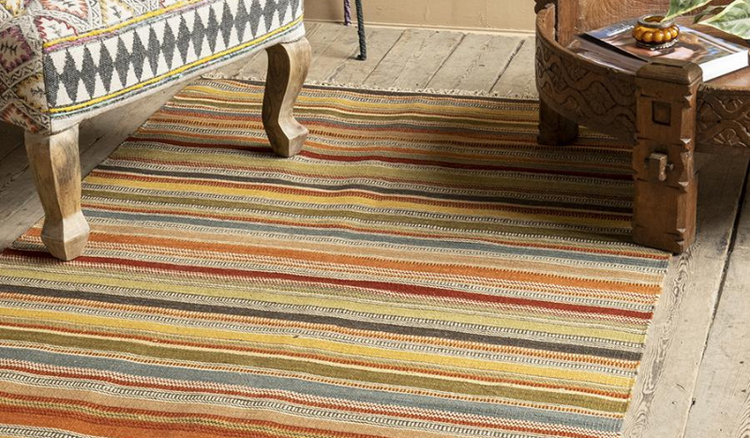Collection: Kilim Rugs
If you’re in search of something 100% unique and eye-catching, furnishing your home with a kilim rug is the way to go. Whether you’re on the market for a small runner rug to brighten up the decor, or a larger one that will illuminate the entire space, we have many sizes, shapes, and patterns available!

No products found
Use fewer filters or remove all
Vintage Kilim Rugs
Vintage kilim rugs are hand-woven vintage rugs made and used by nomadic tribes living in Central Asia and other places such as Iran, Turkey, Anatolia, and the Caucasus. It is distinct from other carpets because a Kilim rug has its own sense of style, pattern, and surface that does not consist of single stitches thrown over the warps. Instead, these hand-woven ... Read More
Vintage Kilim Rugs
Vintage kilim rugs are hand-woven vintage rugs made and used by nomadic tribes living in Central Asia and other places such as Iran, Turkey, Anatolia, and the Caucasus. It is distinct from other carpets because a Kilim rug has its own sense of style, pattern, and surface that does not consist of single stitches thrown over the warps. Instead, these hand-woven rugs are woven with weft balls that go back and forth between the warps.
What Are Kilim Rugs?
Authentic Kilim rugs are thin, flat carpets with the same look on both sides. Kilim rug patterns are mostly geometric. This is because of the specific weaving technique used in making them. Weavers self-interpret shapes and images that exist in nature to turn them into motifs for their craft, a process called "styling."
The word Kilim means "flat weave" in English; however, the term's origin is a mystery from the Persian Empire. It was translated into many languages resulting in diverse cultures. Furthermore, they are perfectly matched with any furniture, and they are made from either wool or cotton, which vary in different prices.
How Are Vintage Kilim Rugs Made?
Kilim weaving is one of the oldest traditional techniques of rug weaving known since ancient times. It is a pile-free weaving method based on two thread systems, without reverse and flat. Weavers generally make a collection of Kilim rugs on wooden looms called "Istar." These looms are placed vertically and twisted on the hoop formed by yarn wefts called "ars" and "argac."
Since incorporating them takes more than a few days, attention is paid to allocating a special place. This place needs to be well lit for ventilation and to process the motifs meticulously. First, the loom sitting on a smooth surface is set up. After this, the skeleton of the flat weave is passed to the warp.
Kilim also differs according to their single and double wing features, with widths varying between 50 and 120 cm. in size and length that varies between 1 and 2 m. Kilim weaving is also used in making sacks and pillows.
History Of Hand Woven Kilim Rugs
The oldest Kilim rugs that had survived to this present age date back to the 18th dynasty of Ancient Egypt when the tomb of Tuthmosis was found. In Anatolia, the first woven Kilim rug collection, called queen's cover, was found during the Troy excavations, and similar rugs were also unearthed in Gordio's excavation. Additionally, some flat-woven rugs (such as the famous Hun carpet) dating back to the 5th-4th B.C. were found in Pazyryk, Southern Siberia.
In the early days, Kilim rugs were thought to be of Turkish origin because of the same flat weaving technique used in making them. This was when the Turks came to Anatolia and brought the weaving culture from Turkey along with them. And this was passed on to other countries such as Morocco and India. The design was a combination of textiles using wool and cotton fiber that helped produce a great variety of Kilim rugs through generations.
From a cultural point of view, Kilim rugs are believed to be a work of art that bridges the past to the present age. It has its own cultural identity that makes it unique. Commonly, it carries the colors and symbolic forms according to where it is made. In nomadic culture, Kilim is an ancestral heirloom that preserves all information about how they lived in ancient times. Due to these features, the originality of design and colors enhances its importance and cultural function.
Kilims vs. Vintage Rugs: The Main Difference
Kilim is similar to vintage rugs in terms of material, quality, and dye. Looking at the technique used when producing carpets and kilims, we see that kilims are not woven like rugs. They are made mainly by knitting the yarns by intertwining and passing them through the center of each other, a technique called flatweave.
Aside from that, the motif of a Kilim is evident on the face of the rug, which creates a flat base that is resulted from weaving wefts and warps together. While in rug production, yarns of different colors, generally wool or cotton, are knitted on the warps and held together by pressing the wefts tightly together.
Since Kilim rugs are made with ancient techniques, they are not very common in decorating many houses today. Hence, carpets are used more than them. In addition, kilims possess a larger room space than rugs. Furthermore, it usually takes one month to make kilims, while weaving a wool carpet can take 4-5 months. The style patterns of Kilims are generally more symmetrical, but this symmetry is not looked for in the rugs.
Main Motifs Used In A Kilim Rug
What's authentic about a kilim rug is because of its motif. The motifs embroidered on the flat weavings on kilim rugs differ according to the characteristics of the region's culture, traditions, and customs. It is also according to the expectations and hopes of the person who weaves the rug. They used these to transmit their legacy for generations to come.
As indicated earlier, kilim patterns are symmetrical. Thus, they usually consist of geometric motifs due to the weaving method. Patterning the kilim surface is possible in three ways.
- Pre-woven rugs are used as models.
- The weaver designs and colors as they want.
- Drawn patterns are used.
Kilim Area Rugs Motif Types
It is possible to classify carpet and kilim motifs in various ways.
- Animal motifs: Bird, dragon, insect.
- Floral motifs: tree, leaf, flower, fruit.
- Geometric motifs: Triangle, quadrilateral, rectangle, rhombus, quadrangle
- Mixed motifs: Medallion, rosette, hook, column, inscription, letter, cloud, Chintamani, vase.
- Symbolic motifs: Symbolizes the forces of nature with thoughts and ideas. Bird, tree of life, hand cross, comb, ibrik (a pitcher), and oil lamp motifs can be given examples.
Kilim Rug Motif Meanings
Here is some meaning of kilim motifs written in order below:
Nutmeg and Amulet
Nutmeg is believed to reduce the effect of evil eyes. In addition, the amulet protects its owner from harmful events.
Eagle
A sign of power and might.
Earring
With this motif, a young girl who wants to get married indirectly reveals her desire for her family.
Eye
It is believed to protect against evil eyes and harm.
Abundance
The hand on the waist and the belaying cleat are used together to represent man and woman. The eye in the middle of the motif protects the family from evil.
Trammel
It indicates family unity and the hope of being together.
Hand, Finger, Comb
Fingers protect the person from evil eyes. The hand motif signifies fertility, and the comb symbolizes birth.
Pitrak
It usually means abundant flowers, which means abundance in general.
Storage Chest
It symbolizes the dowry chest of young girls.
Hook And Plus
Pluses (+) and hooks are frequently used in Turkish weaving to protect people from danger.
Dragon
The dragon is the lord of air and water. It is believed to bring bountiful spring rains.
Bird
Owl and crow evils, nightingale and pigeon; good luck symbols.
Hand On Her Waist
It is a symbol of motherhood, femininity, and fertility.
Hair Tie
This one expresses the desire to marry. The hair involved in weaving represents immortality.
Belaying Cleat
The belaying cleat symbolizes productivity, strength, and masculinity. Also, it means that the person who weaves is very happy.
Waterline
Water and its path emphasize the importance of water in human life.
The Scorpion
It is woven to protect from the evil of the Scorpion.
The Star
This one represents productivity and often means a clean soul.
The Tree Of Life
This motif is the symbol of eternity.
Common Characteristics Of Colors used In Kilim Production
Looking at vintage kilim rugs, from time to time, we might wonder what's its story and meaning. Most weavers say that each symbol on these rugs is a code. Based on their colors come with different explanations. For instance, pink is used to symbolize spring and love, while red is a symbol of grief and pain. White symbolizes birth, and green is the color of meeting God in Sufism, which symbolizes happiness in the family.
Most of these colors come from traditional dyeing recipes that weavers learn and repeat by passing to the next generation. Some of which utilize root dyes that are obtained from natural products. Apart from root dye, some plants or fruits are also used.
For example, the brown and red area acquired from subsoil shoots of plants and yellowish tones can be procured from Buckthorn plants. Insects can also be used to make pigments, such as the insect chermes abiertis's blood which is used to obtain the red color.
The colors are crucial in Kilims; their secret has passed from generation to generation for centuries. As the information about its colors passed between ages, it's also interesting that the shades and colors hint at the region in which it was made.
Fun fact! Rug specialists can easily understand and pinpoint the village it is from just by looking at its colors!
Artistic Value of Kilim Production
We have to state that Kilims' have a stunning collection of colors. Together with the motifs, they create an incredible and authentic selection that does much to lift the room and add a joyful dose of color. Kilims can add a new soul to the room, adding texture and warmth, especially to bare floor spaces. However, there is more than that! They do have an artistic value, which many people do not recognize.
If we go back in time, especially in the Middle East, we can see that people have engaged in artistic pursuits and efforts. On every page of history, creative endeavors have been more complex to understand than naturalistic endeavors. The concept of art has been visualized by beauty in works that people create by thinking that directs to clarity.
Since there are natural and sincere orientations and social and cultural influences in the concept of art, the criteria, and tastes that determine the exquisite quality of art; were created differently worldwide. Hence, the various considerations that are used in kilims are different.
To know the symbolic meanings of motif and pattern compositions for the society in Kilims, it is essential to understand its aesthetic values, cultural integrity, and semantic depth. In addition, symmetry element is widespread in the arrangement of motif and pattern compositions of Kilims. However, the weaver's placement of filling motifs in different places increases their artistic value.
Where To Buy Kilim Rugs?
If you want to search for Turkish kilim rugs, shop at Biev, and we guarantee that it is the online site you are looking for.
We have all kinds of Kilim rugs for sale that you can choose from, including antique kilim rugs, vintage Turkish kilim rugs, flat weave kilim rugs, kilim runner rugs, and modern kilim rugs, and tribal kilim rugs.
Aside from that, we have various geometric kilim rugs, boho kilim rugs, kilim wool rugs, and many more!
Read Less